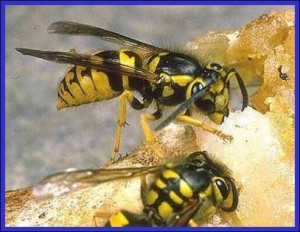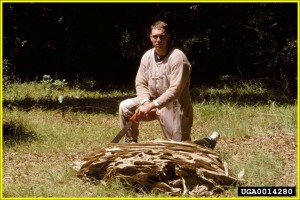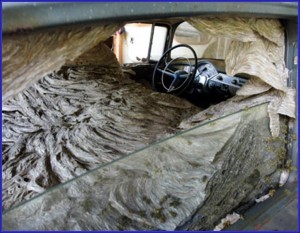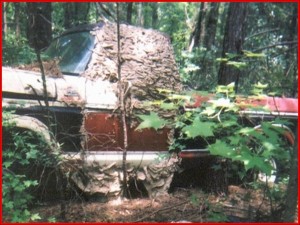
Yellowjackets
Yellowjackets (Vespula spp.)
Yellowjackets are the most troublesome wasp pests in Michigan because they nest in and around homes and other structures, and because they are attracted to many of the foods we enjoy eating outdoors. The German Yellowjacket, Vespula germanica, is a species that commonly nests in wall voids, attics, crawlspaces and other enclosed cavities. The Eastern Yellowjacket, Vespula maculifrons, and most other yellowjackets build their nests underground that are usually started in an abandoned mammal burrow. Yellowjacket nests are constructed of a papermache-like material that the wasps make by mixing their saliva with chewed, weathered wood. Nests are arranged in layers of brood cells where the larvae are reared. Yellowjackets feed primarily on live prey such as flies, caterpillars, and other insects. Some species like the German and eastern yellowjackets will forage for meat from carcasses, garbage and picnic tables. They will also forage for sugars such as beer, fruit, sweet beverages, and the honeydew produced by aphids and scale insects. Sugars are particularly important to the new developing queens in late summer. This behavior of foraging for human foods brings people and these yellowjackets in frequent conflict, especially in the late summer and early fall when yellowjacket numbers peaks and other “natural” food sources begin to decline.
Yellowjackets and other wasp species do not use the same nest again the following year. New queens start a new nest each spring; although a favorable nest site maybe chosen year after year if adequate space is available. New queens, which are the only members of the colony that survive the winter, do not overwinter in the nest. They leave the nest in the fall and overwinter under tree bark and other protected sites. The workers usually die out by the first of November. The best method of controlling yellowjackets is to locate the nest and treat it with a registered insecticide. Hornet and Wasp sprays are effective in killing individual wasps and much like shooting skeet, they also provide a certain amount of recreation. However, serious wasp control requires that the nest be located and treated directly.
Under no circumstance should a nest opening in an outside wall of house be plugged; this will only force the wasps to chew their way into the living area. The nest opening should be caulked shut in the following spring to prevent wasps from returning and building a new nest in this same area. Applying Sevin Garden Dust directly to the nest opening can control ground-nesting species. It is always best to treat wasp nests at night when the entrance is not being used and most of the wasps are inside the nest. Protect yourself before hand by wearing eye goggles, leather gloves and heavy winter clothes. If a flashlight is required to locate the nest opening, place the flashlight on the ground and direct the beam at the opening. Do not hold the flashlight as many species will come at the light after the dust is applied. Once the dust is applied leave the area immediately as fast as your little legs will carry you. Yellowjackets seem to enjoy stinging folks and unlike honeybees that can only sting once, yellowjackets can sting repeatedly. Be smart, be careful, and be quick. If you feel that you don’t want to attempt control yourself, pest control companies are always available to perform this service for you, although this maybe quite expensive.







 Print
Print Email
Email




